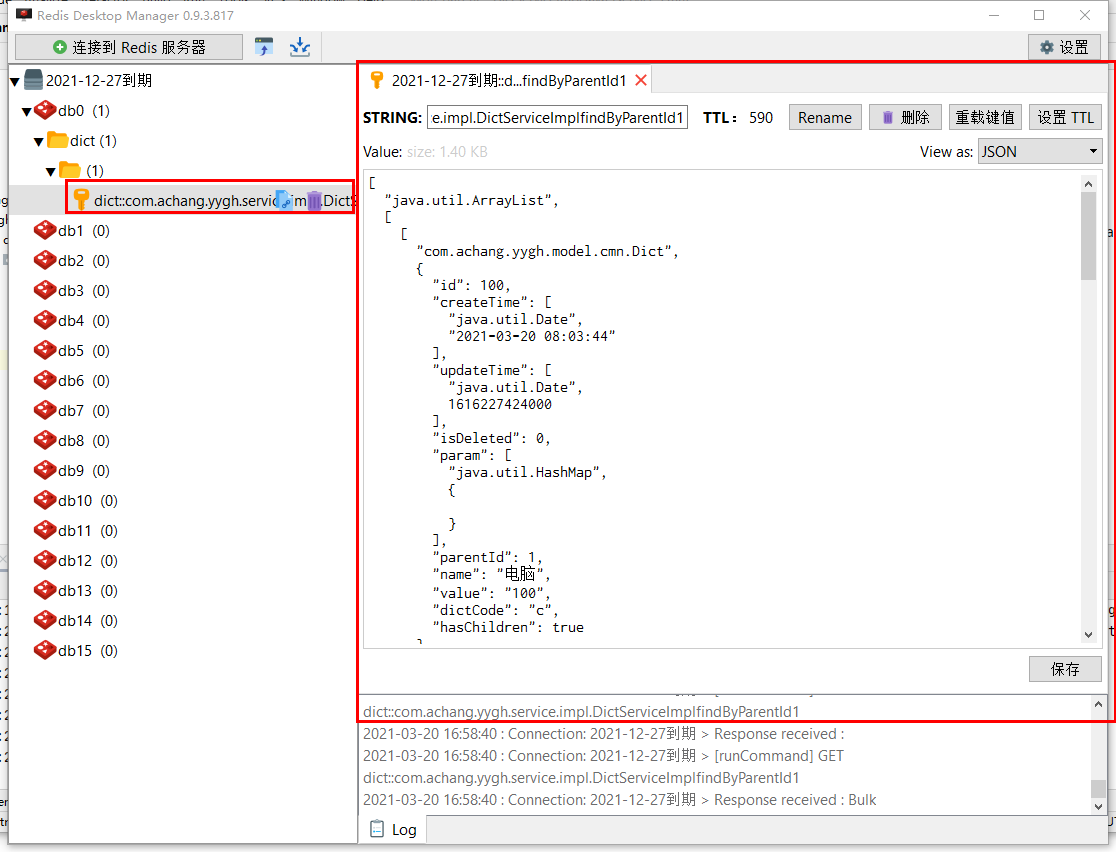尚医通
一、配置nginx
由于我们后端有很多服务模块,每个模块都有对应的访问路径与端口,为了提供统一的api接口,所以使用nginx作为反向代理服务器;
反向代理,其实客户端对代理是无感知的,因为客户端不需要任何配置就可以访问,我们只需要将请求发送到反向代理服务器,由反向代理服务器去选择目标服务器获取数据后,在返回给客户端,此时反向代理服务器和目标服务器对外就是一个服务器,暴露的是代理服务器地址,隐藏了真实服务器IP地址
1,下载安装nginx(window版)
2,配置nginx
server {
listen 80;
server_name localhost;
location /admin/hosp/ {
proxy_pass http://localhost:8201;
}
location /admin/cmn/ {
proxy_pass http://localhost:8205;
}
}
3,调整/config/dev.env.js中的BASE_API
BASE_API: ‘http://localhost:80’

说明:
1、后续添加service模块自行添加nginx配置,不做说明
2、后续我们将了Spring Cloud Gateway网关,将替代nginx网关
二、数据字典介绍
何为数据字典?数据字典就是管理系统常用的分类数据或者一些固定数据,例如:省市区三级联动数据、民族数据、行业数据、学历数据等,由于该系统大量使用这种数据,所以我们要做一个数据管理方便管理系统数据,一般系统基本都会做数据管理。
1、页面效果
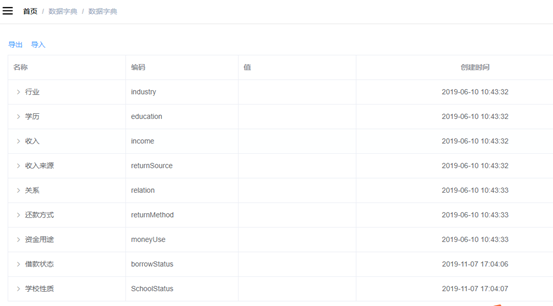
2、表设计
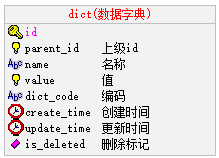
#
# Database "yygh_cmn"
#
CREATE DATABASE IF NOT EXISTS `yygh_cmn` CHARACTER SET utf8;
USE `yygh_cmn`;
#
# Structure for table "dict"
#
CREATE TABLE `dict` (
`id` bigint(20) NOT NULL DEFAULT '0' COMMENT 'id',
`parent_id` bigint(20) NOT NULL DEFAULT '0' COMMENT '上级id',
`name` varchar(100) NOT NULL DEFAULT '' COMMENT '名称',
`value` bigint(20) DEFAULT NULL COMMENT '值',
`dict_code` varchar(20) DEFAULT NULL COMMENT '编码',
`create_time` timestamp NOT NULL DEFAULT CURRENT_TIMESTAMP COMMENT '创建时间',
`update_time` timestamp NOT NULL DEFAULT CURRENT_TIMESTAMP ON UPDATE CURRENT_TIMESTAMP COMMENT '更新时间',
`is_deleted` tinyint(3) NOT NULL DEFAULT '1' COMMENT '删除标记(0:不可用 1:可用)',
PRIMARY KEY (`id`),
KEY `idx_dict_code` (`dict_code`),
KEY `idx_parent_id` (`parent_id`)
) ENGINE=InnoDB DEFAULT CHARSET=utf8 COMMENT='组织架构表';
3、数据分析
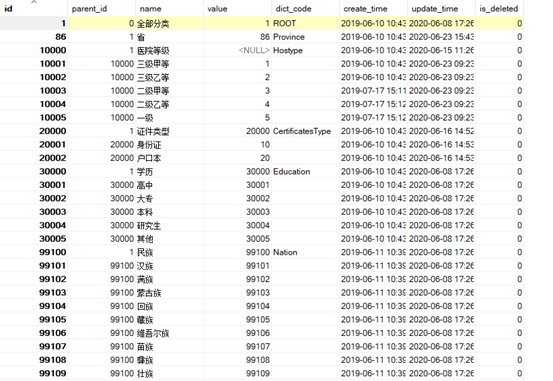
parent_id:
上级id,通过id与parent_id构建上下级关系,例如:我们要获取所有行业数据,那么只需要查询parent_id=20000的数据
name:名称,例如:填写用户信息,我们要select标签选择民族,“汉族”就是数据字典的名称
value:值,例如:填写用户信息,我们要select标签选择民族,“1”(汉族的标识)就是数据字典的值
dict_code:编码,编码是我们自定义的,全局唯一,例如:我们要获取行业数据,我们可以通过parent_id获取,但是parent_id是不确定的,所以我们可以根据编码来获取行业数据
说明:系统中会使用省市区三级联动数据,该数据我们来自“国家统计局”官方数据,地址:http://www.stats.gov.cn/tjsj/tjbz/tjyqhdmhcxhfdm/2019/index.html
4,根据页面效果分析数据接口
数据字典是树形展示,由于数据众多,我们使用“树形数据与懒加载”的方式展现数据列表,其他就是对数据的新增、修改与删除操作,因此需要提供的接口如下:
1,根据上级id获取下级数据(构造树形数据),参考文档:https://element.eleme.cn/#/zhCN/component/table,页面搜索:树形数据与懒加载
2,导入接口
3,导出接口
接下来我们封装服务器端数据接口,接口测试通过后再做页面渲染
三、数据字典开发
1,搭建service-cmn模块
1.1 搭建service-cmn模块
搭建过程参考service-hosp模块
1.2 修改配置
修改pom.xml
<?xml version="1.0" encoding="UTF-8"?>
<project xmlns="http://maven.apache.org/POM/4.0.0"
xmlns:xsi="http://www.w3.org/2001/XMLSchema-instance"
xsi:schemaLocation="http://maven.apache.org/POM/4.0.0 http://maven.apache.org/xsd/maven-4.0.0.xsd">
<parent>
<artifactId>service</artifactId>
<groupId>com.achang</groupId>
<version>0.0.1-SNAPSHOT</version>
</parent>
<modelVersion>4.0.0</modelVersion>
<packaging>jar</packaging>
<artifactId>service-cmn</artifactId>
<dependencies></dependencies>
<build>
<finalName>service-cmn</finalName>
<plugins>
<plugin>
<groupId>org.springframework.boot</groupId>
<artifactId>spring-boot-maven-plugin</artifactId>
</plugin>
</plugins>
</build>
</project>
1、添加配置文件application.properties
# 服务端口
server.port=8205
# 服务名
spring.application.name=service-cmn
# 环境设置:dev、test、prod
spring.profiles.active=dev
# mysql数据库连接
spring.datasource.driver-class-name=com.mysql.jdbc.Driver
spring.datasource.url=jdbc:mysql://localhost:3306/yygh_cmn?characterEncoding=utf-8&useSSL=false
spring.datasource.username=root
spring.datasource.password=00000
#返回json的全局时间格式
spring.jackson.date-format=yyyy-MM-dd HH:mm:ss
spring.jackson.time-zone=GMT+8
1.3 启动类
package com.achang.yygh;
@SpringBootApplication
@ComponentScan("com.achang")
public class ServiceCmnMain8205 {
public static void main(String[] args) {
SpringApplication.run(ServiceCmnMain8205.class,args);
}
}
- 配置类
package com.achang.yygh.config;
@Configuration
@MapperScan("com.achang.yygh.mapper")
public class HospConfig {
//分页插件
@Bean
public PaginationInterceptor paginationInterceptor(){
return new PaginationInterceptor();
}
}
2、数据字典列表
根据element组件要求,返回列表数据必须包含hasChildren字典,如图:
https://element.eleme.cn/#/zh-CN/component/table

2.1 数据字典列表接口
2.1.1 model模块添加数据字典实体
在model模块查看实体:com.achang.yygh.model.cmn.Dict
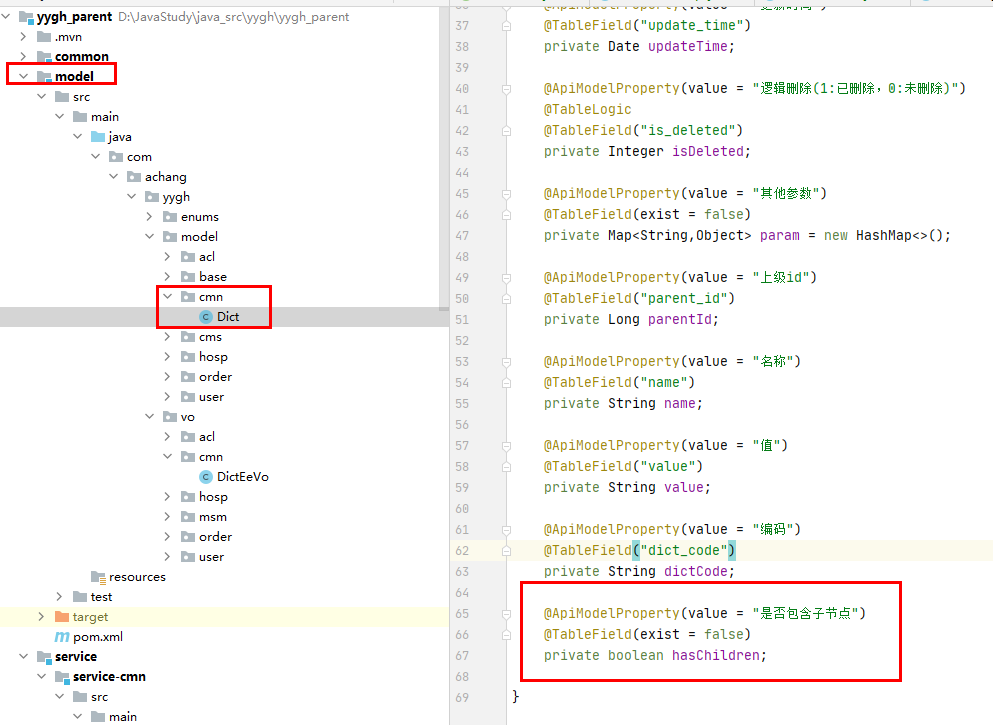
说明:hasChildren为树形组件所需字典,标识为数据库表中不存在该字段,所以在entity对象中添加这个属性,因为element-ui使用层级关系需要用到这个属性来判断是否有下一级
2.1.2 添加数据字典mapper
com.achang.yygh.mapper
package com.achang.yygh.mapper;
public interface DictMapper extends BaseMapper<Dict> {
}
2.1.3 添加数据字典service
1、添加com.achang.yygh.service.DictService
public interface DictService extends IService<Dict> {
根据id查询子节点数据列表
List<Dict> findByParentId(Long id);
}
2、添加com.achang.yygh.service.impl.DictServiceImpl接口实现
@Service
public class DictServiceImpl extends ServiceImpl<DictMapper, Dict> implements DictService {
//根据id查询子节点数据列表
@Override
public List<Dict> findByParentId(Long id) {
QueryWrapper<Dict> wrapper = new QueryWrapper<>();
wrapper.eq("parent_id",id);
List<Dict> dictList = baseMapper.selectList(wrapper);
for (Dict dict : dictList) {
Long dictId = dict.getId();
boolean hasChild = this.hasChild(dictId);
dict.setHasChildren(hasChild);
}
return dictList;
}
//判断id下面是否有子节点
private boolean hasChild(Long id){
QueryWrapper<Dict> wrapper = new QueryWrapper<>();
wrapper.eq("parent_id",id);
Integer count = baseMapper.selectCount(wrapper);
return count > 0;
}
}
2.1.4 添加数据字典controller
添加com.achang.yygh.controller.DictController
@RestController
@RequestMapping("/admin/cmn/dict")
public class DictController {
@Autowired
private DictService dictService;
//根据id查询子节点数据列表
@GetMapping("/findByParentId/{id}")
public Result findByParentId(@PathVariable Long id){
List<Dict> list = dictService.findByParentId(id);
return Result.ok(list);
}
}
2.2 数据字典列表前端
2.2.1 添加路由
在 src/router/index.js 文件添加路由
{
path: '/cmn',
component: Layout,
redirect: '/cmn/list',
name: '数据管理',
meta: {
title: '数据管理', icon: 'example' },
children: [
{
path: 'list',
name: '数据字典',
component: () => import('@/views/dict/list'),
meta: {
title: '数据字典', icon: 'table' }
}
]
}
说明:列表与查看都添加了
2.2.2 定义api
创建文件 src/api/cmn/dict.js
import request from '@/utils/request'
export default {
//根据id查询子节点数据列表
getHospSetList(id) {
return request({
url: `/admin/cmn/dict/findByParentId/${
id}`,
method: 'get'
})
},
}
2.2.3 方法调用
<script>
import dict from '../../api/dict'
export default {
name: "list",
created() {
this.getListById(1)
},
methods:{
//根据id查询子节点列表
getListById(id){
dict.getHospSetList(id).then(resp=>{
this.dictList = resp.data;
})
},
//查询下面层级内容
//element-ui帮我们封装了,tree为每次查找的id值
getChildrens(tree, treeNode, resolve) {
dict.getHospSetList(tree.id).then(response => {
resolve(response.data)
})
},
},
data() {
return {
dictList:[],
}
},
}
</script>
2.2.3 表格渲染
<template>
<div class="app-container">
<el-table
:data="dictList"
style="width: 100%"
row-key="id"
border
lazy
:load="getChildrens"
:tree-props="{children: 'children', hasChildren: 'hasChildren'}">
<el-table-column label="名称" width="230" align="left">
<template slot-scope="scope">
<span>{
{ scope.row.name }}</span>
</template>
</el-table-column>
<el-table-column label="编码" width="220">
<template slot-scope="{row}">
{
{ row.dictCode }}
</template>
</el-table-column>
<el-table-column label="值" width="230" align="left">
<template slot-scope="scope">
<span>{
{ scope.row.value }}</span>
</template>
</el-table-column>
<el-table-column label="创建时间" align="center">
<template slot-scope="scope">
<span>{
{ scope.row.createTime }}</span>
</template>
</el-table-column>
</el-table>
</div>
</template>
- 效果
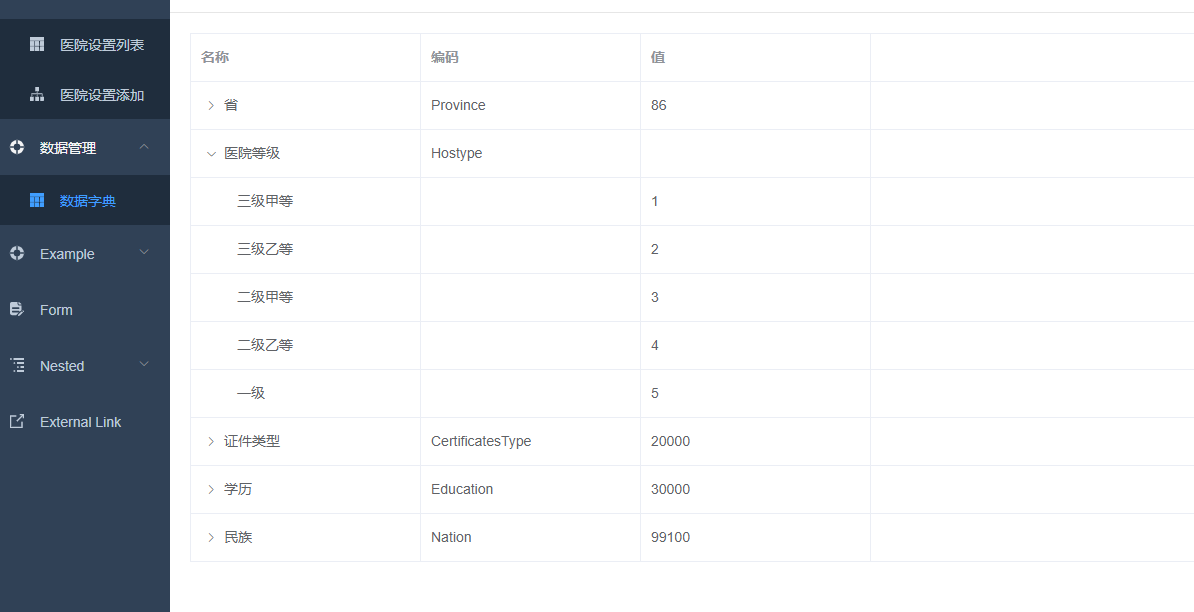
3、EasyExcel介绍
Java解析、生成Excel比较有名的框架有Apache poi、jxl。但他们都存在一个严重的问题就是非常的耗内存,poi有一套SAX模式的API可以一定程度的解决一些内存溢出的问题,但POI还是有一些缺陷,比如07版Excel解压缩以及解压后存储都是在内存中完成的,内存消耗依然很大。easyexcel重写了poi对07版Excel的解析,能够原本一个3M的excel用POI sax依然需要100M左右内存降低到几M,并且再大的excel不会出现内存溢出,03版依赖POI的sax模式。在上层做了模型转换的封装,让使用者更加简单方便。
EasyExcel是一个基于Java的简单、省内存的读写Excel的开源项目。在尽可能节约内存的情况下支持读写百M的Excel。
文档地址:https://alibaba-easyexcel.github.io/index.html
github地址:https://github.com/alibaba/easyexcel
3.1 导出示例
示例链接:https://alibaba-easyexcel.github.io/quickstart/write.html
3.2 导入示例
示例链接:https://alibaba-easyexcel.github.io/quickstart/read.html
3.3 EasyExcel集成
3.3.1 添加依赖
1,添加依赖
<dependencies>
<!-- https://mvnrepository.com/artifact/com.alibaba/easyexcel -->
<dependency>
<groupId>com.alibaba</groupId>
<artifactId>easyexcel</artifactId>
<version>2.1.1</version>
</dependency>
</dependencies>
说明:我们已经在yygh-parent中的pom.xml中添加了所有依赖管理
2,导入导出需要定义对象,对象上需要引用easyexcel标签,所以model模块需要引入
scope:provided
<dependency>
<groupId>com.alibaba</groupId>
<artifactId>easyexcel</artifactId>
<scope>provided </scope>
</dependency>
3,导入导出我们会把它封装成工具类,放在common-util中,所有模块公用,所以该模块也得引入
<dependency>
<groupId>com.alibaba</groupId>
<artifactId>easyexcel</artifactId>
</dependency>
4、数据字典导出
4.1 导出接口封装
4.1.1 在model模块添加导出实体
在model模块查看实体:com.achang.yygh.vo.cmn.DictEeVo
@ExcelProperty设置excel表头的内容
@Data
public class DictEeVo {
@ExcelProperty(value = "id" ,index = 0)
private Long id;
@ExcelProperty(value = "上级id" ,index = 1)
private Long parentId;
@ExcelProperty(value = "名称" ,index = 2)
private String name;
@ExcelProperty(value = "值" ,index = 3)
private String value;
@ExcelProperty(value = "编码" ,index = 4)
private String dictCode;
}
4.1.2 在service-cmn模块添加service方法
1、在DictService类添加接口
public interface DictService extends IService<Dict> {
//导出数据字典接口
void exportDictData(HttpServletResponse response);
}
2、在DictServiceImpl类添加接口实现类
//导出数据字典接口
@Override
public void exportDictData(HttpServletResponse response) {
try{
//设置编码集
response.setCharacterEncoding("utf-8");
//设置输出的文件格式
response.setContentType("application/vnd.ms-excel");
//设置文件名
String fileName = "dict";
//拼接输出的文件名和文件格式
response.setHeader("Content-disposition","attachment;filename="+fileName+".xlsx");
//查询数据库数据
List<Dict> dictList = baseMapper.selectList(null);
ArrayList<DictEeVo> voArrayList = new ArrayList<>(dictList.size());
//将查询数据库的数据封装到对应的vo类中,并装到vo集合中
for (Dict dict : dictList) {
DictEeVo dictEeVo = new DictEeVo();
BeanUtils.copyProperties(dict,dictEeVo,DictEeVo.class);
voArrayList.add(dictEeVo);
}
EasyExcel.write(response.getOutputStream(),DictEeVo.class)
.sheet("数据字典")
.doWrite(voArrayList);
}catch (IOException e){
e.printStackTrace();
}
}
4.1.3 在service-cmn模块添加controller方法
在DictController类添加方法
//导出数据字典接口
@GetMapping("/exportData")
public Result exportData(HttpServletResponse response){
dictService.exportDictData(response);
return Result.ok();
}
4.1.4 测试
直接通过浏览器导出数据:http://localhost:8205/admin/cmn/dict/exportData
4.2 导出前端实现
4.2.1 列表页面添加导出按钮
src/views/cmn/dict/list.vue
<el-button type="primary" plain @click="exportDict">导出字典数据</el-button>
4.2.2 添加导出方法
//导出数据字典数据
exportDict(){
//直接去请求接口
window.location.href="http://localhost:8205/admin/cmn/dict/exportData"
},
4.2.1 测试
5、数据字典导入
5.1 导入接口封装
5.1.1 创建回调监听器
package com.achang.yygh.listener;
public class DictListener extends AnalysisEventListener<DictEeVo> {
private DictMapper mapper;
//通过构造器获取到mapper对象操作数据库
public DictListener(DictMapper mapper){
this.mapper=mapper;
}
//一行一行读
@Override
public void invoke(DictEeVo dictEeVo, AnalysisContext analysisContext) {
Dict dict = new Dict();
BeanUtils.copyProperties(dictEeVo,dict);
//加入数据库
mapper.insert(dict);
}
@Override
public void doAfterAllAnalysed(AnalysisContext analysisContext) {
}
}
5.1.2 在service-cmn模块添加service方法
- 接口
public interface DictService extends IService<Dict> {
//导入数据字典接口
void importData(MultipartFile file);
}
- impl
//导入数据字典接口
@Override
public void importData(MultipartFile file) {
try {
EasyExcel.read(file.getInputStream(),DictEeVo.class,new DictListener(baseMapper))
.sheet()
.doRead();
} catch (IOException e) {
e.printStackTrace();
}
}
5.1.3 在service-cmn模块添加controller方法
在DictController类添加方法
//导入数据字典接口
@PostMapping("/importData")
public Result importData(MultipartFile file){
dictService.importData(file);
return Result.ok();
}
5.2 导入前端实现
5.2.1 列表页面添加导入按钮
src/views/cmn/dict/list.vue
<el-button type="success" @click="importDict">导入字典数据</el-button>
5.2.2 添加导入弹出层
<!--导入弹出框-->
<el-dialog title="导入" :visible.sync="dialogImportVisible" width="480px">
<el-form label-position="right" label-width="170px">
<el-form-item label="文件">
<el-upload
:multiple="false"
:on-success="onUploadSuccess"
:action="'http://localhost:8205/admin/cmn/dict/importData'"
class="upload-demo">
<el-button size="small" type="primary">点击上传</el-button>
<div slot="tip" class="el-upload__tip">只能上传excel文件,且不超过500kb</div>
</el-upload>
</el-form-item>
</el-form>
<div slot="footer" class="dialog-footer">
<el-button @click="dialogImportVisible = false">
取消
</el-button>
</div>
</el-dialog>
5.2.3 添加弹出可见模型
data() {
return {
dictList:[],
dialogImportVisible: false,
listLoading: true,
}
}
5.2.4 添加方法
methods:{
onUploadSuccess(response, file){
this.$message.info('上传成功')
//关闭弹框
this.dialogImportVisible = false
//刷新页面
this.getListById(1)
},
//出入数据字典数据
importDict(){
//显示弹出框
this.dialogImportVisible=true
}
}
- 注意,阿昌这里测试,读取导入excel文件,前端一直不显示
后面发现是数据库isDelete逻辑删除字段默认的值为1,也就是说我导入的数据,他默认就是被删除的,所以再查询的时候就不会查询我导入的数据,所有就显示不出来
- 解决方法
将默认值改为0
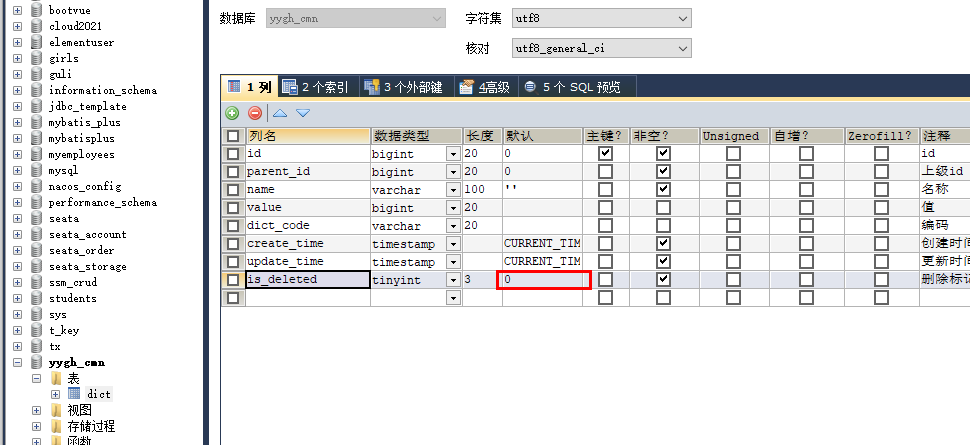
四、Spring Cache + Redis 缓存数据
Spring Cache 是一个非常优秀的缓存组件。自Spring 3.1起,提供了类似于@Transactional注解事务的注解Cache支持,且提供了Cache抽象,方便切换各种底层Cache(如:redis)
使用Spring Cache的好处:
1,提供基本的Cache抽象,方便切换各种底层Cache;
2,通过注解Cache可以实现类似于事务一样,缓存逻辑透明的应用到我们的业务代码上,且只需要更少的代码就可以完成;
3,提供事务回滚时也自动回滚缓存;
4,支持比较复杂的缓存逻辑;
1、项目集成Spring Cache + Redis
因为缓存也是公共使用,所有的service模块都有可能使用缓存,所以我们把依赖与部分配置加在service-util模块,这样其他service模块都可以使用了
1.1 service-util添加依赖
在service-util模块的pom.xml添加依赖
<!-- redis -->
<dependency>
<groupId>org.springframework.boot</groupId>
<artifactId>spring-boot-starter-data-redis</artifactId>
</dependency>
<!-- spring2.X集成redis所需common-pool2-->
<dependency>
<groupId>org.apache.commons</groupId>
<artifactId>commons-pool2</artifactId>
<version>2.6.0</version>
</dependency>
1.2 service-util添加配置类
创建com.achang.yygh.common.config.RedisConfig
package com.achang.yygh.common.config;
import com.fasterxml.jackson.annotation.JsonAutoDetect;
import com.fasterxml.jackson.annotation.PropertyAccessor;
import com.fasterxml.jackson.databind.ObjectMapper;
import org.springframework.cache.CacheManager;
import org.springframework.cache.annotation.EnableCaching;
import org.springframework.cache.interceptor.KeyGenerator;
import org.springframework.context.annotation.Bean;
import org.springframework.context.annotation.Configuration;
import org.springframework.data.redis.cache.RedisCacheConfiguration;
import org.springframework.data.redis.cache.RedisCacheManager;
import org.springframework.data.redis.connection.RedisConnectionFactory;
import org.springframework.data.redis.core.RedisTemplate;
import org.springframework.data.redis.serializer.Jackson2JsonRedisSerializer;
import org.springframework.data.redis.serializer.RedisSerializationContext;
import org.springframework.data.redis.serializer.RedisSerializer;
import org.springframework.data.redis.serializer.StringRedisSerializer;
import java.lang.reflect.Method;
import java.time.Duration;
/******
@author 阿昌
@create 2021-03-20 16:20
*******
*/
@Configuration
@EnableCaching
public class RedisConfig {
/**
* 自定义key规则
* @return
*/
@Bean
public KeyGenerator keyGenerator() {
return new KeyGenerator() {
@Override
public Object generate(Object target, Method method, Object... params) {
StringBuilder sb = new StringBuilder();
sb.append(target.getClass().getName());
sb.append(method.getName());
for (Object obj : params) {
sb.append(obj.toString());
}
return sb.toString();
}
};
}
/**
* 设置RedisTemplate规则
* @param redisConnectionFactory
* @return
*/
@Bean
public RedisTemplate<Object, Object> redisTemplate(RedisConnectionFactory redisConnectionFactory) {
RedisTemplate<Object, Object> redisTemplate = new RedisTemplate<>();
redisTemplate.setConnectionFactory(redisConnectionFactory);
Jackson2JsonRedisSerializer jackson2JsonRedisSerializer = new Jackson2JsonRedisSerializer(Object.class);
//解决查询缓存转换异常的问题
ObjectMapper om = new ObjectMapper();
// 指定要序列化的域,field,get和set,以及修饰符范围,ANY是都有包括private和public
om.setVisibility(PropertyAccessor.ALL, JsonAutoDetect.Visibility.ANY);
// 指定序列化输入的类型,类必须是非final修饰的,final修饰的类,比如String,Integer等会跑出异常
om.enableDefaultTyping(ObjectMapper.DefaultTyping.NON_FINAL);
jackson2JsonRedisSerializer.setObjectMapper(om);
//序列号key value
redisTemplate.setKeySerializer(new StringRedisSerializer());
redisTemplate.setValueSerializer(jackson2JsonRedisSerializer);
redisTemplate.setHashKeySerializer(new StringRedisSerializer());
redisTemplate.setHashValueSerializer(jackson2JsonRedisSerializer);
redisTemplate.afterPropertiesSet();
return redisTemplate;
}
/**
* 设置CacheManager缓存规则
* @param factory
* @return
*/
@Bean
public CacheManager cacheManager(RedisConnectionFactory factory) {
RedisSerializer<String> redisSerializer = new StringRedisSerializer();
Jackson2JsonRedisSerializer jackson2JsonRedisSerializer = new Jackson2JsonRedisSerializer(Object.class);
//解决查询缓存转换异常的问题
ObjectMapper om = new ObjectMapper();
om.setVisibility(PropertyAccessor.ALL, JsonAutoDetect.Visibility.ANY);
om.enableDefaultTyping(ObjectMapper.DefaultTyping.NON_FINAL);
jackson2JsonRedisSerializer.setObjectMapper(om);
// 配置序列化(解决乱码的问题),过期时间600秒
RedisCacheConfiguration config = RedisCacheConfiguration.defaultCacheConfig()
.entryTtl(Duration.ofSeconds(600))
.serializeKeysWith(RedisSerializationContext.SerializationPair.fromSerializer(redisSerializer))
.serializeValuesWith(RedisSerializationContext.SerializationPair.fromSerializer(jackson2JsonRedisSerializer))
.disableCachingNullValues();
RedisCacheManager cacheManager = RedisCacheManager.builder(factory)
.cacheDefaults(config)
.build();
return cacheManager;
}
}
说明:
@EnableCaching:标记注解 @EnableCaching,开启缓存,并配置Redis缓存管理器。@EnableCaching 注释触发后置处理器, 检查每一个Spring bean 的 public 方法是否存在缓存注解。如果找到这样的一个注释, 自动创建一个代理拦截方法调用和处理相应的缓存行为。
1.3 service-cmn添加redis配置
#redis配置
spring.redis.host=47.120.237.184
spring.redis.port=6379
spring.redis.password=ach2ng@123356
spring.redis.database= 0
spring.redis.timeout=1800000
#redis池设置
spring.redis.lettuce.pool.max-active=20
spring.redis.lettuce.pool.max-wait=-1
#最大阻塞等待时间(负数表示没限制)
spring.redis.lettuce.pool.max-idle=5
spring.redis.lettuce.pool.min-idle=0
2、使用Spring Cache
2.1 常用缓存标签
2.1.2 缓存@Cacheable
根据方法对其返回结果进行缓存,下次请求时,如果缓存存在,则直接读取缓存数据返回;如果缓存不存在,则执行方法,并把返回的结果存入缓存中。一般用在查询方法上。
查看源码,属性值如下:
| 属性/方法名 | 解释 |
|---|---|
| value | 缓存名,必填,它指定了你的缓存存放在哪块命名空间 |
| cacheNames | 与 value 差不多,二选一即可 |
| key | 可选属性,可以使用 SpEL 标签自定义缓存的key |
2.1.2 缓存@CachePut
使用该注解标志的方法,每次都会执行,并将结果存入指定的缓存中。其他方法可以直接从响应的缓存中读取缓存数据,而不需要再去查询数据库。一般用在新增方法上。
查看源码,属性值如下:
| 属性/方法名 | 解释 |
|---|---|
| value | 缓存名,必填,它指定了你的缓存存放在哪块命名空间 |
| cacheNames | 与 value 差不多,二选一即可 |
| key | 可选属性,可以使用 SpEL 标签自定义缓存的key |
2.1.3 缓存@CacheEvict
使用该注解标志的方法,会清空指定的缓存。一般用在更新或者删除方法上
查看源码,属性值如下:
| 属性/方法名 | 解释 |
|---|---|
| value | 缓存名,必填,它指定了你的缓存存放在哪块命名空间 |
| cacheNames | 与 value 差不多,二选一即可 |
| key | 可选属性,可以使用 SpEL 标签自定义缓存的key |
| allEntries | 是否清空所有缓存,默认为 false。如果指定为 true,则方法调用后将立即清空所有的缓存 |
| beforeInvocation | 是否在方法执行前就清空,默认为 false。如果指定为 true,则在方法执行前就会清空缓存 |
2.2 数据字典应用
改造com.achang.yygh.cmn.service.impl.DictServiceImpl类方法
@Service
public class DictServiceImpl extends ServiceImpl<DictMapper, Dict> implements DictService {
//根据id查询子节点数据列表
//keyGenerator:key的生成个规则,指定为我们上面redisconfig配置类中指定的生成规则
@Cacheable(value = "dict",keyGenerator = "keyGenerator")
@Override
public List<Dict> findByParentId(Long id) {
QueryWrapper<Dict> wrapper = new QueryWrapper<>();
wrapper.eq("parent_id",id);
List<Dict> dictList = baseMapper.selectList(wrapper);
for (Dict dict : dictList) {
Long dictId = dict.getId();
boolean hasChild = this.hasChild(dictId);
dict.setHasChildren(hasChild);
}
return dictList;
}
//导入数据字典接口
@Override
//allEntries = true: 方法调用后清空所有缓存
@CacheEvict(value = "dict", allEntries=true)
public void importData(MultipartFile file) {
try {
EasyExcel.read(file.getInputStream(),DictEeVo.class,new DictListener(baseMapper))
.sheet()
.doRead();
} catch (IOException e) {
e.printStackTrace();
}
}
}
- 测试
